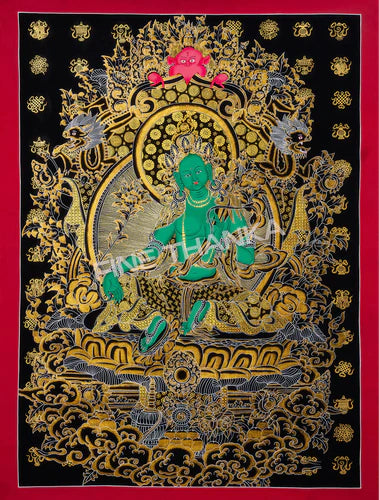
Who is Green Tara? Learn Everything About Her Divine Power
Share
In the world of Thangka art, Green Tara stands out as a symbol of strength and compassion, guiding practitioners on their spiritual journeys.
From her powerful role as a protector to the intricate details in her artistic portrayal, Green Tara’s presence in Thangka art is a journey of spiritual awakening.
If you're ready to discover the rich symbolism and secrets of Green Tara Thangka, let's get started with her fascinating story!
Who is Green Tara?
Green Tara is celebrated as the goddess who offers protection from both material and spiritual dangers. As a goddess of action, she helps her devotees overcome obstacles and challenges with her unwavering compassion.
Her journey begins as a bodhisattva—an enlightened being who chooses to remain in the world to assist others on their spiritual path. According to Tibetan Buddhist mythology, Green Tara was born from the tears of Avalokiteshvara, the Bodhisattva of Compassion. One tear, falling from Avalokiteshvara’s eye, transformed into a radiant lotus, from which Tara emerged.
This divine act of compassion marked the beginning of her role as a protector and helper, guiding beings toward liberation and spiritual peace.
The Power of Green Tara
Green Tara’s power knows no bounds. She is depicted as a powerful force that offers rapid protection and relief from suffering. Her power is not limited to the physical realm; it also affects the mental and spiritual transformation of her followers.
Green Tara’s compassion is evident in her readiness to protect against various fears—whether it's the fear of death, obstacles in life, or even spiritual failure.
By invoking her presence, devotees believe they can clear the path to enlightenment, moving swiftly toward liberation. Her dynamic energy helps those in need, guiding them through life's struggles with grace and support.
Posture and Mudras of Green Tara
As you can see in the given image, Green Tara’s portrayal in thangka art is a beautiful testament to her compassion and her ever-present readiness to protect.
She sits gracefully in a lotus position, embodying purity and calm, with her left leg slightly extended—a dynamic posture that signals her willingness to spring into action at any moment to aid those in need.
Her right hand, raised in the Abhaya Mudra, offers a reassuring gesture of protection, while her left hand delicately holds a utpala flower, symbolizing her boundless compassion and spiritual purity.
Every detail, from her poised posture to the gentle mudras, reflects her role as a compassionate guardian, always prepared to guide her followers toward safety and enlightenment.
Symbolism and Significance of Green Tara Paintings
The Green Tara thangka is a profound representation of compassion and protection, filled with rich symbolism. Her vibrant green color embodies vitality, action, and life-force, while the lotus she sits upon symbolizes spiritual purity, enlightenment, and her transcendence over worldly struggles. Her mudras (hand gestures) emphasize her divine roles—offering compassion, protection, and unwavering support to those on their spiritual paths.
In Tibetan Buddhism, Green Tara holds profound significance, embodying the belief that compassion is an active, transformative force. Her presence in thangka art serves as a bridge between the material and spiritual realms, extending her blessings and guidance to anyone seeking comfort, courage, or clarity.
Green Tara Mantra
During meditation, practitioners visualize Green Tara goddess seated on a lotus, embodying her qualities of protection and swift assistance. This powerful visualization is enhanced by the recitation of her sacred mantra, “ཨོཾ་ཏཱ་རེ་ཏུ་ཏཱ་རེ་ཏུ་རེ་སྟོད།" (Om Tare Tuttare Ture Soha), believed to summon her blessings and dissolve obstacles in one’s path. The mantra’s vibrations are said to bring swift relief from suffering and foster positive transformation.
Here's a breakdown of the green tara mantra meaning.
- OM: Represents Tara’s enlightened body, speech, and mind, embodying her purity and spiritual essence.
- TARE: Symbolizes liberation from samsara (the cycle of birth and death). It highlights Tara’s function as “the liberator,” freeing us from suffering and attachment to worldly illusions.
- TUTTARE: Represents the dispelling of fears, particularly the eight great fears or dangers that stem from inner afflictions and are symbolized by external threats: ignorance, hatred, attachment, pride, jealousy, wrong view, doubt, miserliness.
- TURE: This part of the mantra signifies Tara’s ability to bring swift relief from suffering and obstacles, helping us overcome challenges on the path to enlightenment.
- SOHA: A concluding syllable that seals the blessings and invokes the mantra’s full potency, affirming our connection to Tara’s energy and compassionate assistance.
Alongside the mantra, devotees also recite the Twenty-One Praises of Tara, a series of praises that celebrate her qualities and deepen their connection with her protective energy. Through these practices, practitioners invite Green Tara’s divine support and guidance, seeking her help to advance on their spiritual journey with courage and resilience.
Types of Green Tara
Each type of Green Tara carries unique traits that embody different facets of compassion, protection, and empowerment. Whether seated or standing, the variations in her posture, mudras (hand gestures), and the accompanying symbols serve as visual cues for practitioners.
Each depiction holds a deeper meaning, inviting practitioners to connect with her divine presence in a personalized way. Here are some types:
Arya Tara
Arya Tara, or Noble Tara, symbolizes compassion and liberation. She is often depicted with a serene expression, seated on a lotus throne with one leg extended, ready to assist those in need. Her left hand typically holds a blue lotus, representing purity and enlightenment, while her right hand is in the varada mudra (gesture of giving). Practitioners engage in meditation focused on Arya Tara, reciting her mantra "Om Tare Tuttare Ture Soha" to invoke her blessings for protection and swift assistance.
Mahattari Tara
This Tara of deep meditation and healing strength is often depicted in dark green, symbolizing her powerful role as protector and healer. Her posture conveys tranquility and readiness to assist those who seek her help. Mahattari Tara is invoked for healing purposes and protection from fears and dangers. Practitioners may visualize her during meditation and recite mantras to connect with her nurturing qualities.
Khadiravam Tara
A nurturing presence, Khadiravam Tara is called upon for physical and emotional healing. Her motherly figure offers comfort, helping practitioners overcome health-related obstacles. Practitioners may engage in specific rituals or meditations focused on Khadiravam Tara to seek her assistance in overcoming health-related challenges.
Vasya Tara
Vasya Tara symbolizes attraction and control over negative influences. She is depicted holding objects that signify her power to draw positive energies toward practitioners while dispelling negativity. Vasya Tara is often invoked in practices aimed at enhancing personal magnetism and influence over situations or individuals. Reciting her mantras helps practitioners cultivate confidence and assertiveness.
Mahasri Tara
Representing prosperity, Mahasri Tara is surrounded by symbols of wealth. This form of Tara is invoked for material success and well-being in life. Practitioners may engage in rituals that focus on Mahasri Tara to attract financial stability and prosperity into their lives.
Varada Tara
The Tara of generosity, depicted with four goddesses, she blesses practitioners with kindness and support. Her mantras enhance one's ability to give and receive graciously.
Durgottarini Tara
Durgottarini Tara symbolizes protection against dangers and fears. She is depicted with four arms, holding various implements that signify her protective qualities. This form of Tara is invoked during times of crisis or danger to seek refuge from harm. Practitioners may engage in specific prayers or rituals to connect with Durgottarini Tara for safety and security.
Dhanada Tara
As the Wealth-Granting Tara, she symbolizes abundance and prosperity. She is depicted holding a rosary or other symbols of wealth, emphasizing her role in bestowing material success upon practitioners. Dhanada Tara is invoked for financial blessings, and practitioners may engage in rituals or recite mantras to attract wealth into their lives.
Jahguli Tara
Jahguli Tara can appear in various colors depending on context, each signifying unique protective qualities. This form of Tara embodies the essence of protection against malevolent forces or negative energies. Practitioners may visualize Jahguli Tara during meditation or recite specific prayers to enhance their sense of security.
Parnasaban Tara
Connected to nature, Parnasaban Tara is surrounded by trees and flowers, symbolizing growth and healing through nature’s power. She supports those seeking harmony with the environment. Practitioners invoke Parnasaban Tara for support in connecting with nature's healing qualities, often engaging in outdoor meditations or rituals that honor the earth.
Differences Between Green Tara and White Tara
While Green Tara and White Tara share many similarities, they also embody different aspects of spiritual practice. Green Tara is the goddess of swift action and protection, embodying active compassion, while White Tara, known for her serene energy, focuses on spiritual healing and longevity. Here's a brief summary of their differences:
|
Aspect
|
Green Tara
|
White Tara
|
|
Posture
|
Dynamic with one leg extended
|
Serene with both legs crossed
|
|
Mudras
|
Varada Mudra
|
Healing gestures
|
|
Symbolism
|
Active compassion and swift action
|
Nurturing compassion and wisdom
|
|
Color
|
Portrayed in vibrant green
|
Shown in white
|
Conclusion
At Fine Thanka Art, our skilled artists bring Green Tara to life, crafting each painting with precision and reverence, capturing the essence of her protective and compassionate energy.
Visit our gallery or shop our collection to bring the powerful presence of Green Tara into your own space.
Fine Thanka
Green Tara
Green Tara
"ཨོཾ་ཏཱ་རེ་ཏུ་ཏཱ་རེ་ཏུ་རེ་སྟོད།" (Om Tare Tuttare Ture Soha)
Bring the dynamic energy of Green Tara, the "Mother of Liberation," into your space with this exquisitely hand-painted thangka. Revered for her swift action and compassionate power, Green Tara protects against obstacles, fears, and spiritual challenges, guiding you toward peace and prosperity.
Chant her mantra while meditating with this Green Tara Thangka and invite her blessings of protection and guidance.
Crafted by skilled Nepali artisans with natural pigments, it captures Green Tara’s serene presence amidst blooming lotus blossoms.
Perfect for your meditation room, sacred space, or as a meaningful gift, this thangka inspires protection, clarity, and inner peace.
Product Specifications:
- Hand-painted
- Size: 70 cm x 100 cm
- Material: Cotton Canvas
- Origination: Nepal
Regular price Rs35,000.00 NPR
Regular price Sale price Rs35,000.00 NPR
Unit price / per
Pickup available at Thamel
Usually ready in 5+ days
Share
You may also like
-
White Tara
Regular price Rs120,000.00 NPRRegular priceUnit price / per -
White Tara
Regular price Rs35,000.00 NPRRegular priceUnit price / per -
Mantra Mandala
Regular price Rs14,000.00 NPRRegular priceUnit price / per -
Mantra Mandala
Regular price Rs19,000.00 NPRRegular priceUnit price / per





